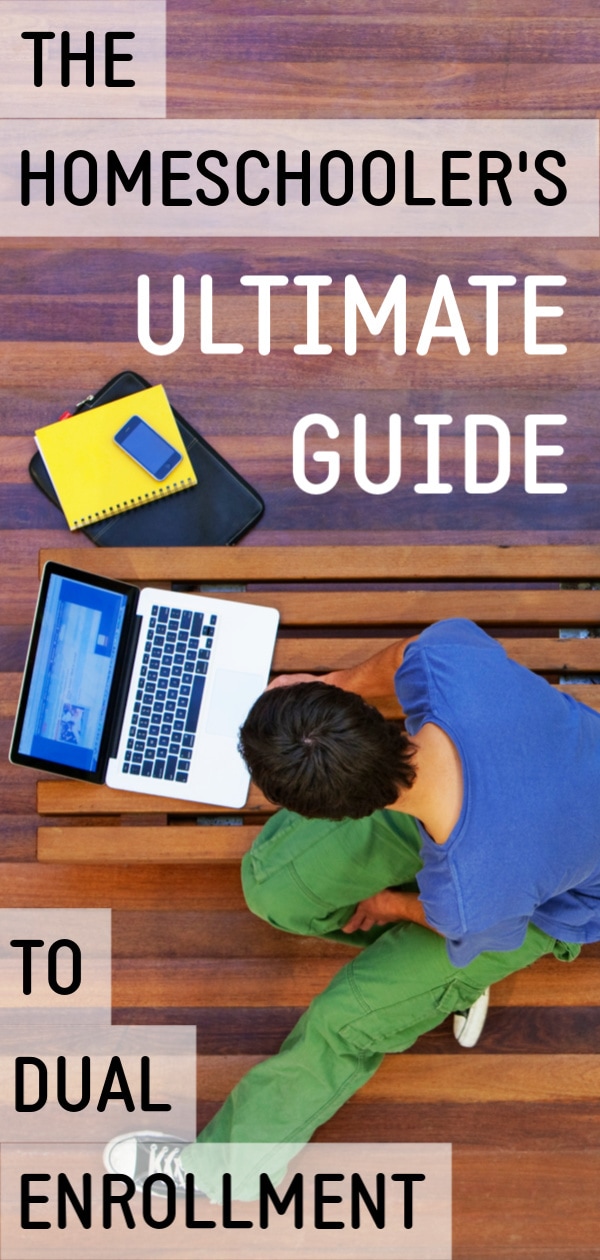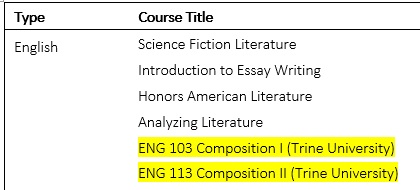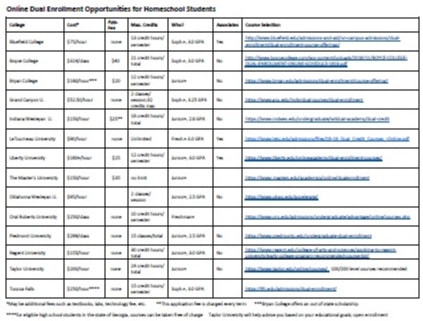Are you interested in dual enrollment for homeschoolers? What is it? How do you do it? Why? Read this guide to find out.

Dual credit, dual enrollment, early college enrollment, credit-in-escrow–I’ve heard it called many things. When I was in high school (yes, 392 years ago), I had the opportunity to take a few classes this way and loved it. It actually saved my hide the second semester of my freshman year. I only had enough money to pay for 12 credit hours. Completing two courses in high school, gave me a bit of squeak room.
One question I’ve fielded multiple times throughout the homeschool journey: “But you are going to put them in school for high school, aren’t you?”
Well, I wasn’t planning on it.
Because of my own dual enrollment experience, I knew that my students could opt to take college courses in high school, if that’s what they want to do.
Disclaimer #1: Dual enrollment is not the best option for every homeschool student or homeschool family. It has, however, been an amazing experience for one of my students.
Disclaimer #2: Dual enrollment is not necessary for homeschool high school graduation.

What Does Dual Enrollment Mean?
Dual enrollment is taking a college class and simultaneously receiving college credit and high school credit at the same time. Win-win.
Note: Some institutions use the terms dual enrollment and dual credit interchangeably while others do not. Some define dual enrollment as a high school student enrolled in a college-level class, but the coursework does not meet any high school graduation requirement. Only college credit is earned. These same institutions use the term dual credit to designate a student fulfilling high school credit along with college credit.
For homeschool students, the variation in meaning doesn’t matter since mom is the one who determines what counts as high school credit.

Benefits of Dual Enrollment for Homeschoolers
Why would we choose to enroll in college while still in high school?
Save Time
Receiving credit for two classes (such as English Comp I and 11th grade English) at the same time saves time. Yes, English Composition I is more intense than a typical 11th grade English class, but if my student completes English Composition I, he doesn’t have to spend any time taking 11th grade English.
Save Money
In our state we have ample opportunities for dual enrollment ranging from $20-$75/credit hour. This is magnificent savings as our community college charges $150/credit hour. Regular tuition at local, private universities ranges from $700-$800/credit hour. Some of the dual enrollment opportunities my son is presented with are cheaper than buying homeschooling curriculum.
Other states offer FREE dual credit opportunities for students. Start by checking with your local colleges. If you are looking for online dual enrollment options, look through my chart (posted later in this post).
Prepare for College
What? How can a student prepare for college if he is in college?
The thing about dual enrollment is that my student is still living at home with his own personal teacher and guidance counselor (um, that’s me) who is still guiding him.
When Elijah took his first online class, I taught him how to organize his notebook (something I hadn’t ever done before); I walked him through MLA format (another something I hadn’t done before). I am still here to mentor and tutor him as needed.Elijah is currently enrolled in his 4th dual enrollment course, and he has steadily gained independence and confidence. He has also discovered beneficial resources provided by his learning institutions—such as music study table and Tutor.com.
Most students start with one dual enrollment course.Taking one class helps a student understand the rigor required of a college course. Allowing dual enrollment in high school helps with the learning curve before a student is enrolled full-time–balancing five classes at once.
Another part of learning to prepare for college is learning how to communicate with professors. When Elijah needed to email a professor concerning an issue, he asked me to proofread the email. This is part of the mentoring and guiding process, and Elijah learned how to advocate for himself.
Interaction with classmates has also been an important gained skill. Group projects can be a nightmare for homeschooled students who usually work independently. Learning how to compromise and have reasonable expectations for group members are great skills to learn while still at home and in high school.
Demonstrate College Readiness
I know this sounds crazy since my last point was to prepare for college, but when a college sees dual enrollment courses with passing grades on the transcript, the college knows your student is ready.
Some homeschool moms might want to throat punch me for saying this, but passing college grades on a high school transcript validates all the other grades on the homeschool transcript. (Not that we need to be validated, but it certainly doesn’t hurt.)
Continue Interest-led Learning
Elijah chose two music theory classes this year as part of his dual enrollment line-up. This was great news for me because I am not equipped to teach him anything about music. At all. He has had an amazing experience learning more about he loves topics (7th chord inversions, anyone?). Honestly, this is the biggest benefit for me: providing my son with educational opportunities he is excited about.
Explore Potential Careers
My son doesn’t know what he wants to do beyond high school, and that’s okay.
Dual enrollment has gifted him the opportunity to take various classes without the pressure of the class needing to fit into a degree program and without the pressure of choosing a major next semester.
He has also had the opportunity to investigate career paths by taking a myriad of introductory classes. (I highly suggest auditing classes to explore potential careers, but that’s another post.)

Things to Consider Before Dual Enrollment
Okay, before dual enrollment starts to sound all peaches-and-cream, you need to weigh the pros and the cons before your student makes the commitment.
Loss of Flexibility
Most teens who are homeschooled already have demanding schedules with sports, jobs, volunteer work, co-op, etc., but dual enrollment definitely adds another tier of obligation. We can’t just whisk away for an impromptu field trip day. Everything has to be mapped out around the college’s schedule. We have found more flexibility with online classes, but weekly deadlines still have to be met.
Readiness
Dual enrollment is not the best path for every homeschooled student.
Look. Elijah is on the dual enrollment train. I didn’t push, drag, or throw him. I showed him a potential path to earn an associate’s degree in high school, and he jumped aboard with a, “Yes. I want THIS.” Without his drive, he’d be on the wrong track.
Before you zealously start signing up your student for all the things, please make sure your student is ready, has demonstrated maturity, and shows motivation to learn in the college environment.
Introduction to Mature Topics
College classrooms are full of adults. College campus environments often include a party-hearty attitude with a sex, alcohol, and drugs atmosphere; this can be hard for high school students to filter through.
Even at a school with a worldview which aligns with the view of your student, topics may be uncomfortable. Obviously, a college algebra course will have less opportunity for mature subject matter than a psychology or sociology class.
However, most students who have part-time jobs have already been thrown into the same adult world. This can be a positive, though, as you can facilitate open and honest conversations about what is happening at school and work while your student is still at home, under your care.

How Homeschoolers Can Prepare for Dual Enrollment
Your student will benefit from having these skills before she begins a dual enrollment course.
Note-Taking
Your student doesn’t need to be a note-taking ninja before her first dual enrollment class, but she should at least be comfortable with the task.
High school courses such as Mr. D Math and Dave Raymond’s American History both promote good note-taking. Including these courses in 8th-9th grades that will help your student acquire this skill.
Time Management
Waiting to do everything at the last minute may work just fine for high school courses, but it is a much trickier tight rope to walk with a college class–especially if your student is juggling more than one college course. Students need to be able to map out daily tasks in order to accomplish all of his high school and college work.
Understands Deadlines
Y’all. I can’t begin to tell you the conversations I’ve had with college-age students who have classmates who do not understand the consequences for turning in late work. A dual enrolled student should be mature enough to understand the consequences and care enough to get the work done on time.
Writing and Research
Basic essay writing skills are necessary for many dual credit courses. Knowing how to conduct basic academic research will also be a benefit.
Open to Instruction
I have heard college professors make this complaint about the current generation of homeschool students: they think they already know everything. Ouch!
Rather than getting defensive, we should consider the claim. Is my student teachable?
Humility is an important trait to possess, and while we could be snarky about the professor’s incorrect homonym use on the syllabus, maybe we should, instead, realize that humans make mistakes. Our students should be teachable and actively looking for new skills they can gain from each professor.

Dual Enrollment Programs for Homeschoolers
Many options exist for homeschool students who want to dual enroll. You can check your local options by checking the websites of your local colleges and universities. After I read through the information on the website, I make a list of questions and call the dual enrollment coordinator.
The enrollment process is usually simple. Your student completes an application. You send in a transcript. Wait until the university contacts your student to let her know if she has been admitted. Choose a class. Pay the bill. Start the class.
Here are some private colleges currently offering online options for homeschoolers:
- Bluefield College
- Boyce College
- Bryan College
- Grand Canyon University
- Indiana Wesleyan University
- LeTourneau University
- Liberty University
- The Master’s University
- Oklahoma Wesleyan University
- Oral Roberts University
- Piedmont International University
- Regent University
- Taylor University
Taylor University offers a flexible, open enrollment program. Students can start a class at any time and have four months to complete it. This is fantastic for homeschool families who want to keep a flexible schedule. - Toccoa Falls College
Some options are more expensive than others. Consider this as your choose. If you know a certain university is your student’s end point school, it may be well worth the cost. Otherwise, it may not.
I created a chart to give you a quick overview of the online options.
Download the Dual Enrollment Chart
How to Add Dual Credit to the Transcript
If you haven’t started making a transcript for your student yet, it’s okay. Learn how to do that in this post.
Passing a college class shows a college that your student is ready for higher learning, and it is something you want to highlight on the transcript.
I indicate dual credit courses by adding the college course number before the course title. Then, in parenthesis, I add the name of the university where my son completed the course.
I snagged a piece of my son’s transcript, so you can see how I added dual enrollment courses to his transcript.


Dual Enrollment for Homeschoolers FAQ
Will dual enrollment classes transfer to any college?
No. You have to do your homework* to find out if courses will transfer for credit to your student’s future college. Since Elijah doesn’t have future plans, we are just winging it. Honestly, even if he never pursues a bachelor’s degree, the classes he has taken have given him invaluable learning opportunities. The best way you can look at dual enrollment is as a learning opportunity.
You may want to check out Transferology—it can guide you through the process. Remember, nothing is guaranteed: colleges change degree requirements all the time. Again, the best way you can look at dual enrollment is as a learning opportunity.
*You will need to look at the general education requirements at the college your student hopes to enroll in after high school graduation. Call the registrar and ask if they will accept the courses from the institution where your student is dual enrolled.
Should my student take a class on campus or online?
This is going to be determined by the local options you have. Our experience is that online courses are more intense and have a greater learning curve (figuring out how to use the online portal). Online courses include discussion boards where students are expected to answer questions provided by the instructor and respond to classmates’ answers. This can feel like busy work, and is not nearly as rich as live classroom discussion. Online courses usually require more independent study and online students don’t have to deal with the campus life environment.
The majority of dual enrollment students prefer on campus classes. Labs and foreign language classes are typically a better experience in the classroom. My son has definitely enjoyed the on campus experience more than his online classes. We have had the opportunity to put him at a small university with a worldview similar to our family’s worldview. He has still been challenged in his thinking (and we don’t think that’s a bad thing!), but I can’t imagine placing him at a learning institution with an opposing worldview.
My advice would be to network with other local families. Find out which professors students recommend. Ask questions of students who have attended classes at the colleges near you.
What are the best classes to take in dual enrollment?
Well, Miss Interest-Led Learning (ahem, that’s me) is going to tell you to start with a class your student wants to take. Motivation will be higher if your student cares about the subject.
Of course, as guidance counselor, you can also appeal to your student’s practical side and note any area on the transcript that needs a boost. If your student only has one science credit (hypothetically speaking, of course), you may want to encourage him to snag another science class.
If you want to be more practical, consider English Composition I, English Composition II, College Algebra, speech, and sociology or psychology. Most of these are mandatory for general education requirements. I am not promising they will transfer, but they are generally required.
Is it possible to have too many credits? Will my student still be eligible for freshman scholarships?
I have heard multiple answers to this question, but the bottom line is that it depends on the future college your student will attend. Here is Dual Credit at Home’s answer to the same question.
What if my student is flailing or failing?
Be familiar with the university’s drop policy. I know a homeschool family whose son had to drop a speech class because the professor bullied him.
We pulled Elijah from an online biology course when we realized that it was going to be too difficult. The instructor was choosing to use different rubrics than the ones provided in the student files. After asking other moms about this same professor, I was given a standard reply, “That class is ridiculously difficult. I’m not sure my student learned anything.” We lost some money by pulling him, but by doing so by a required date, it did not harm his academic record. In retrospect, I wish I would have networked with other moms before Elijah signed up for the class.
Sometimes professors can be grossly inappropriate or ridiculous. My personal opinion is that dual enrollment is not the time to push through these issues. Networking with other families before you sign up for classes, can help you avoid professor problems. If you don’t have other families you can network with, please meet with an academic adviser at the college to determine which classes (based on course content) would be the best fit for your student.
How much high school credit should I give my student for dual credit courses?
I’ve lost sleep over this one. Some sources say a three credit hour college course is equivalent to one semester of high school credit. Other experts assert that a three credit hour college course is equivalent to one full year of high school credit.
However, as the homeschool guidance counselor for your school, you are the final authority. You determine how much credit to award your student for each dual enrollment course she takes.

Please let me know if you have any questions about dual enrollment, or if you have information or a resource I should add to this post.
If you need more homeschool high school help, try this page.


Wow! This is such a well researched, comprehensive article to help parents understand the process of dual enrollment. You’ve obviously done your homework! I am linking this post to our Free Homeschool Resources page. Thanks so much!
Every point you made checked off one of my questions as I started reading! Thanks for your wisdom and especially the graphic you included showing what the transcript with a dual enroll class looks like. I am a visual person and needed to “see” it! I appreciate your hard work on this post – it was super helpful.
A great resource to avoid some professors with a history of issues is https://www.ratemyprofessors.com/
Thank you so much for this information! My son dual enrolled last year and began getting his automotive certifications, which he will finish up this summer. I am completing his transcript so that he can apply for financial aid.
My question is, for a class that lasted a semester, they have credit hours listed as 3.00 or 2.00. How does that translate to the credits I am filling in on his transcript? For example, a regular HS class that lasted a semester would be .5 credits, so I’m not sure what to do with this part. Do you have any advice?
Thank you for writing this article! It’s incredibly informative and has been a great help!
Hi Kara,
I gave a full year credit for a 3 hour college class, and a half year credit for a 2 hour class. So, if you normally give 1 credit for a full year, I’d give 1 credit for a three hour college class. I hope that helps! 🙂 Ami